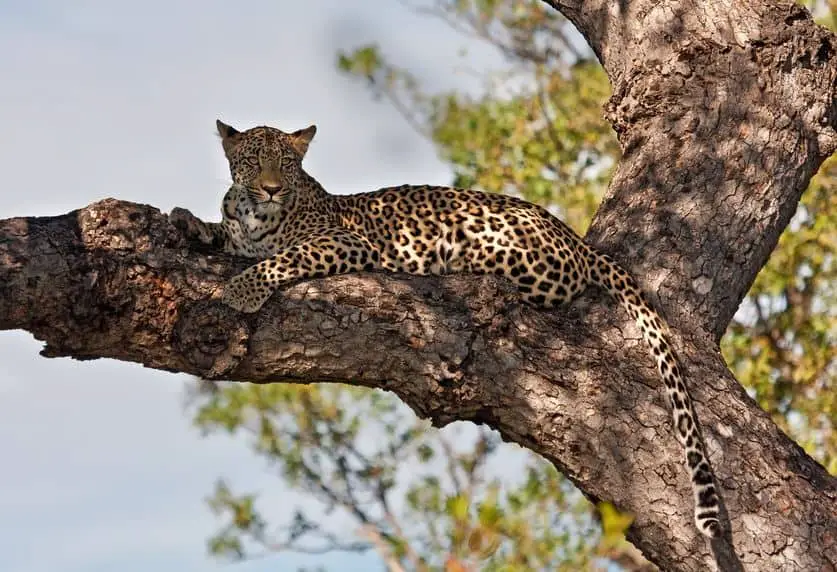
Leopards are amongst Africa’s most skilled hunters and while they are highly elusive animals and therefore hard to spot, there are tricks to increase your chances. For instance, keep an eye on the trees. You might spot a leopard.
Why do you often see leopards in trees? The African leopard often drags its kills up in trees to keep it safe and avoid having it stolen by other predators. The leopard’s raw strength and excellent climbing skills, allows it to drag its kills up into trees to eat and rest in peace.
The full answer to why leopards are often spotted in trees is a bit more detailed so keep reading if you want to learn more.
Leopards Have the Strength to Climb Trees While Carrying Kills
Leopards are solitary creatures which means that they do not have the advantage of outnumbering their prey. In addition to this, the leopard would quickly get outnumbered by other predators such as lions, African wild dogs, or hyenas who usually hunt in groups.
To make up for this, however, the leopard is extremely powerful and efficient on its own.
Despite being the smallest of the so-called big 5, the leopard is incredibly strong. In fact, considering its size, the African leopard is actually one of the strongest African mammals that you can spot on your game drive.
It is not uncommon for leopards to kill prey even larger and heavier than themselves and drag it up to 50 feet (15 meters) into a tree to secure it. This requires some serious strength. Not even the mighty lion, the swift cheetah, or the ruthless hyenas or wild dogs can do this which makes the leopard unique.
Not only are leopards incredibly strong, but they are also excellent climbers which I will get into next.
The combination of raw strength and the leopard’s excellent climbing skills gives them the advantage of being able to have their meal in peace from other predators as well as get to safety in the trees.

Leopards are Excellent Climbers
The leopards’ physiology makes them excellent climbers. For instance, leopards have retractable claws that work as excellent tools for climbing trees.
Their ability to navigate the branches is a truly amazing sight and seeing them actually climb while carrying prey is really something else.
Unlike other African predators such as lions and cheetahs, the leopard spends a large portion of its time in trees. Not only does this allow the big elusive cat to stay in peace from other animals while eating but it also allows the leopard to rest without too much interference from other animals.
It is however not uncommon for leopards to accidentally drop some of their food from the trees. When this happens, scavengers such as hyenas, who have not been blessed with the leopard’s climbing skills, can be both quick and ruthless in claiming the dropped food.
Another great advantage of being such an excellent climber is for leopards to be able to flee effectively from lions, hyenas, or African wild dogs who may be chasing them.
Hyenas, unlike leopards, do not have retractable claws which restrict their ability to climb. African wild dogs are also not able to climb trees and while lions are able to, they are much heavier than leopards which limits them to a larger extent than leopards.
This makes the ability to climb trees so well one of the African leopards several great strengths that set them apart from other African predators.
So to increase your chances of spotting a leopard in the African wilderness during the day, a trick is to keep an eye on the trees. Keep reading to learn some more tricks to spot them.
Leopards like to Rest in Trees
As I have talked about in this post, leopards spend a large amount of their time eating, resting, or sleeping in trees on large branches during the day. This allows them to stay safe and isolated from other predators.
For this reason, it can be a good idea to keep an eye on the trees when looking for leopards.
The large African cat also does an excellent job of staying hidden as the colors and patterns of their fur provide excellent camouflage. This also provides additional security for the leopard.
A trick I have learned is to look for the leopard’s tail hanging from large tree branches. These can stand out and be a good thing to look out for on your game drive when scanning nearby trees for animals.
While leopards are indeed excellent climbers, they do however spend most of their time on the ground, so when you are out on your game drive looking for large African cats and other amazing animals, you should definitely mostly look on the ground (unless you’re looking for birds. They like to fly). But as you can hear, it can also yield some great results to keep an eye on the trees in order to spot the elusive leopard. Again, look for their tail dangling from large branches!
While you can be lucky and spot a leopard during the day, they are nocturnal animals and do most of their hunting during the night so if you want to increase your chances of spotting them on the ground, a trick is to be out before sunrise.

Leopards Hunt at Night so Wake Up Early to Increase Your Chances
Leopards are nocturnal animals and are highly active at night which is when most of their hunting is done. The fact that leopards are nocturnal animals also makes it difficult for humans to spot them but luckily, there are ways.
Waking up as early as possible and driving out just as the sun rises has worked for me personally. I have been fortunate enough to see a leopard not more than 10 feet (3 meters) from our car which was an amazing experience. Just make sure your windows are closed!
Waking up early and driving out before sunrise is generally a good idea for your game drive as many African animals, especially the large cats, are very active during the night as it is colder than during the day.
While mostly nocturnal animals, leopards can still also hunt during the day, and if you’re skilled or lucky enough, you can spot one in daylight. In fact, I was once lucky enough to see a leopard with a freshly caught porcupine in its mouth walking not far from the dirt road where we were parked. This was in the middle of a bright and warm day.
This was a truly amazing sight and it seemed like the porcupine had been able to put up quite a fight since one of its long quills was still sticking out from the side of the leopard. Auch!
I hope this post has given you some insight into both why leopards like to hang out in trees as well as some tricks on how to spot them.
Good luck and have fun on your game drive!

